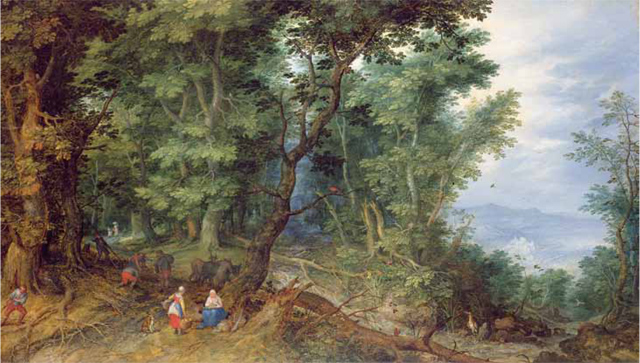My Favourite Painting: Adrian Lester
Adrian Lester chooses his favourite painting for Country Life.


The Flight into Egypt, 1607, 10in by 14in, by Jan Bruegel the Elder (1568–1625), The Hermitage, St Petersburg. Bridgeman Images.
Adrian Lester says: 'I remember my art teacher at school, Mr Malin, trying to explain to me how I should paint depth. He talked about the background having touches of grey the further it went back. I was puzzled. He then dug out a book and showed me this picture. The detail and handling of the technique he had explained was brilliant. Sometimes only half of the picture is shown in books. It was only when I was lucky enough to see it in full years later that I was amazed by the skill of the artist. It was then I learned of the picture’s religious imagery.'
Adrian Lester is an actor and director. The last series of his popular television programme Hustle, can be seen on BBC1 from Friday, January 13
Art critic John McEwen comments: 'Jan Bruegel was one year old when his formidable father, Pieter the Elder, died. Following the death of his mother when he was 10, he was brought up by his grandmother, also an artist. Sometime as a boy, he may have been a pupil of Gillis van Coninxloo (1544–1607), the initiator of the forest landscape in Western art.
This painting, for all its biblical subject, falls within the forest genre, hence its other title, Edge of a Forest, which was imposed during the Communist aberration. The picture, which is painted on copper, entered the then royal Russian collection in 1772. Jan Bruegel went to Italy at a younger age and for a far longer time than his father, arriving about 1589 and leaving in 1596. He settled successively in Naples, Rome and Milan, where he worked for the Archbishop Federico Borromeo.
On his return to Flanders, he eventually became dean of the important artistic Guild of St Luke in Antwerp and was appointed a court painter to the rulers of the Spanish Netherlands, Archduke Albert and Archduchess Isabella. He collaborated on several pictures with his younger Flemish contemporary Rubens; and there is a Rubens portrait of him with his family in the Courtauld Collection. To simplify categorisation, he has been called ‘Velvet’, ‘Flower’ and ‘Paradise’ Bruegel. As these names and this picture show, he was a gentler, more fanciful, painter than his profound and protean father, whose sinister, complementary, Massacre of the Innocents will soon be featured here.'
This article was first published in Country Life, January 11, 2012
Sign up for the Country Life Newsletter
Exquisite houses, the beauty of Nature, and how to get the most from your life, straight to your inbox.
Country Life is unlike any other magazine: the only glossy weekly on the newsstand and the only magazine that has been guest-edited by HRH The King not once, but twice. It is a celebration of modern rural life and all its diverse joys and pleasures — that was first published in Queen Victoria's Diamond Jubilee year. Our eclectic mixture of witty and informative content — from the most up-to-date property news and commentary and a coveted glimpse inside some of the UK's best houses and gardens, to gardening, the arts and interior design, written by experts in their field — still cannot be found in print or online, anywhere else.
-
 'To exist in this world relies on the hands of others': Roger Powell and modern British bookbinding
'To exist in this world relies on the hands of others': Roger Powell and modern British bookbindingAn exhibition on the legendary bookbinder Roger Powell reveals not only his great skill, but serves to reconnect us with the joy, power and importance of real craftsmanship.
By Hussein Kesvani
-
 Spam: The tinned meaty treat that brought a taste of the ‘hot-dog life of Hollywood’ to war-weary Britain
Spam: The tinned meaty treat that brought a taste of the ‘hot-dog life of Hollywood’ to war-weary BritainCourtesy of our ‘special relationship’ with the US, Spam was a culinary phenomenon, says Mary Greene. So much so that in 1944, London’s Simpson’s, renowned for its roast beef, was offering creamed Spam casserole instead.
By Country Life
-
 My favourite painting: Allan Mallinson
My favourite painting: Allan MallinsonMilitary historian Allan Mallinson picks an image of 'faith, generosity and ultimate sacrifice'.
By Charlotte Mullins
-
 My Favourite Painting: Piet Oudolf
My Favourite Painting: Piet Oudolf'One cannot sense whether he is far out on the ocean or closer to shore, or what he may be watching or feeling in that moment as he stares towards the beach.’
By Country Life
-
 My Favourite Painting: Mary Plazas
My Favourite Painting: Mary Plazas'There is compassion, awe, humility, a knowing yet a questioning in the glistening eyes. It moves me, it inspires me beyond the need to know.’
By Country Life
-
 My favourite painting: Robert Kime
My favourite painting: Robert KimeRobert Kime shares his fondness for New Year Snow by Ravilious
By Country Life
-
 My Favourite Painting: Anna Pavord
My Favourite Painting: Anna PavordAnna Pavord chooses a picture which reminds her of where she grew up
By Country Life
-
 My favourite painting: The Duchess of Wellington
My favourite painting: The Duchess of WellingtonThe Duchess of Wellington chooses her favourite painting for Country Life.
By Country Life
-
 My favourite painting: Maureen Lipman
My favourite painting: Maureen LipmanMaureen Lipman chooses her favourite painting for Country Life.
By Country Life
-
 My favourite painting: Jacqueline Wilson
My favourite painting: Jacqueline Wilson'I looked at this painting and decided to write about a Victorian circus girl one day'
By Country Life